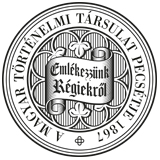Századok – 2016
2016 / 4. szám - MŰHELY - Tevely Arató György: Turos Miklós (1591-1656) Különleges karrier a dunántúli végekről. Egy kiskomáromi főtiszt és családja társadalmi mobilitása
TUROS MIKLÓS (1591-1656) 1007 Nádasdy család szervitorait részben átvevő230 Esterházyak udvarának familiárisi szerkezetéből. Fölvetődik a kérdés a Túrós család kapcsán is, hogy a birtokjogait korábban katonai erőszakkal érvényesítő végvári elit történetére miként hatott a dél-dunántúli, volt hódoltsági birtokok — eredeti birtokosaik és leszármazottaik általi — vissza- és újrafoglalásának hulláma. E társadalomtörténeti igényű kérdésekre is tartogat még válaszokat Túrós Miklós utódainak — itt még megelőlegezhetetlen — 18. századi története. Egyelőre azonban meg kell elégednünk a párhuzammal: amint az utolsó kiskomári vicekapitány nem érte meg életközegének teljes elpusztulását, Kiskomár Kara Musztafa hadai általi 1664. évi lerombolását, úgy tűnt el búvópatakként a nemes Túrós család sorsa is a magyar rendiség döntően átalakuló 18. századi hálózatában, még mielőtt ez a hálózat teljesen fölbomlott volna. A SPECIFIC CARRIER FROM THE TRANSDANUBIAN MARCHES - THE SOCIAL MOBILITY OF MIKLÓS TUROS (1591-1656), OFFICER OF KISKOMÁROM FORTRESS AND HIS FAMILY by György, Tevely Arató Abstract The so called military estate (vitézló' rend) of Hungary, which formed along the border between the Ottoman Empire and the Kingdom of Hungary, is a representative phenomenon of early modern European society. Ottoman conquest threatened the whole Respublica Christiana, and militarized totally Hungarian society living on the edge of the Christian and Muslim worlds. The armed population of the borders had its own law-customs and regarded itself as a separated social caste. Despite the historical significance of this important part of early modern Hungarian society a comprehensice monograph on the problem is still lacking. One of the reasons for this fact is that significant personalities and carrieers of this social group are still virtually unknown. Such a significant member of this social estate can be regarded Miklós Turos (1591—1656), who was vice-captain of the most threatened Hungarian fortress on the Transdanubian territories (Supremus Generalatus Confiniorum Canisae Oppositorum). Turos can be described as a prominent member of the middle class of the military estate, which was „recruited” from semi-rural and fugitive noble and peasant elements of the greater fortresses’ hinterland. All the main attributes of this social layer can be found in his carrier and in his family: coming from obscure origins, Turos elevating himself and his family in one generation’s time, by the second generation his family entered the local noble elite of the period. However, after the particular social circumstances of war-periods vanished, his descendants gradually lost their social position, so closely was the family’s rise linked to militarized society. Miklós Turos is a colourful example of this elusive social phenomenon. An able, assiduous and violent man, he built up his carrier in several areas offered by the conflict zone where he lived. Yet he never left permanently the region of Kiskomárom. Fortunately, the sources allow us to reconstruct the origins of his family, the ways in which he became a landowner in the occupied territories and the hinterland, to see his military advancement, and his and his partners’ role in the Central-European cattle trade. I also examined his change of religion in order to find his place in the period of confessionalisation within the Hungarian nobility, and explored the aspects of his discordance with his captains to demonstrate the specific limits of his social roles. His descendants and relatives conspicuously followed the tracks he had cleared: the valiant forefather opened up career opportunities to three or four generations of his family. 230 Dominkovits P. - Pálffy G.: Nádasdy család i. m. 1118-1119.
